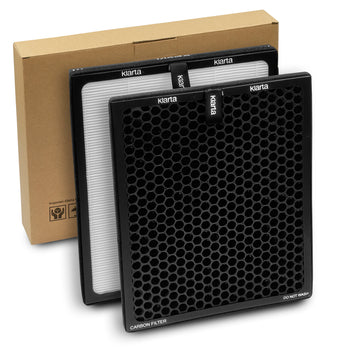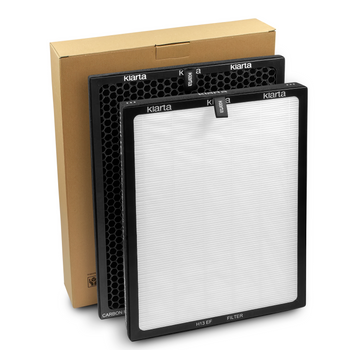
Impact of air pollution on human health - Klarta
Bronchitis, lung cancer, arrhythmia – just three of the many diseases worsened by smog. In this blog post, we present the effects of air pollution on human health and the reasons why it is worth taking care of air quality in your home.

Effects of smog on humans
In Poland, air purifiers are most often bought with protection against smog in mind, so let's start with its impact on the human body.
Cancer
Smog promotes the development of cancer. According to scientists from the International Association for the Study of Lung Cancer, it is the second leading cause of lung cancer after smoking. It is also responsible for 14.1% of all deaths caused by this disease.
Furthermore, the components of smog contribute to many other cancers, such as:
- larynx,
- kidneys,
- brain,
- breasts,
-
blood.
Respiratory diseases
Exposure to smog promotes infections of the lower and upper respiratory tracts, especially the lungs and bronchi. Seniors and children are particularly vulnerable.
For seniors, pneumonia mortality rates increase. In children, colds, coughs, and bronchitis occur at relatively low smog concentrations.
Additionally, polluted air exacerbates the course of respiratory diseases, including asthma and chronic obstructive pulmonary disease (COPD).

Cardiovascular problems
The effects of air pollution on human health can be seen after just a few hours of exposure to smog. Scientists from Fudan University in Shanghai collected data from 2,205 hospitals in 322 cities across China. Their analysis showed that even a few hours of smog exposure can lead to sudden arrhythmia.
Doctors from the Silesian Center for Heart Diseases observed an increase in hospitalizations on smoggy days due to:
- heart attack by 12%,
- stroke by 16%,
-
pulmonary embolism by 18%.
Neurological diseases
Smog also harms the human nervous system from a young age. An international research team conducted studies on brain stem samples from 186 prematurely deceased residents of Mexico City, where smog levels are particularly high.
They found the presence of iron, aluminum, and titanium compounds linked to hyperphosphorylated tau proteins, which are responsible for the development of Alzheimer's disease.
Moreover, the samples contained alpha-synuclein, a protein whose aggregation in cells is typical of diseases such as Alzheimer's, Parkinson's, and dementia.
It's worth noting that the samples came from individuals aged 11 months to 27 years.
Skin problems
The effects of smog on humans also include poorer skin condition. Its particles cause the breakdown of collagen, elastin, and hyaluronic acid. This results in:
- disturbance of the skin's lipid barrier, leading to dryness and slower skin regeneration,
- loss of firmness, resulting in faster wrinkle formation.
Poor fetal development
Women frequently exposed to smog during pregnancy give birth to babies with a birth weight 128 grams lower than those born to mothers living in areas with better air quality.
Furthermore, according to researchers from the University of Utah Health, exposure to smog during pregnancy increases the risk of miscarriage by an average of 16%.

Which air purifier for smog?
We recommend air purifiers equipped with H13 and carbon filters for smog. When choosing, consider the following factors:
- efficiency and maximum working area,
-
presence of an air quality sensor and automatic mode.
Our Klarta Forste and Klarta Stor air purifiers have pre-filters, carbon filters and H13 filters. They are equipped with three automatic modes and precise laser PM2.5 dust meters, the primary component of smog.
Effects of other air pollutants on human health
The impact of air pollution on human health is not limited to smog. We present other hazards present in the air and their effects.
Tobacco smoke
The harmful effects of smoking are well-known. Tobacco smoke contains over 4,000 chemical compounds, more than 60 of which are confirmed carcinogens. Examples of smog components and their effects on the body include:
- nicotine – raises blood pressure, accelerates heart rate,
- nitrogen oxide – increases susceptibility to respiratory infections, damages lungs,
- hydrogen cyanide – used in gas chambers; in smaller amounts, causes headaches, dizziness, and vomiting,
- ammonia – irritates respiratory tracts and eyes,
- benzene – promotes anemia, damages the heart, liver, and adrenal glands.
It's worth noting that smoke settles on nearby objects, reacting with other compounds, leading to the formation of additional harmful substances.
Touching surfaces covered in smoke residue also results in absorbing its components, known as third-hand smoke.
Volatile Organic Compounds (VOCs)
Volatile organic compounds (VOCs) are characterized by their carbon content and their ability to easily vaporize into gas. Examples of VOCs and their sources include:
- formaldehyde – nail polishes, industrial lacquers, air fresheners, wallpaper, glass cleaners,
- acetone – nail polish removers, paints, degreasing agents,
- benzene – dyes, pesticides, solvents,
- ethanol – lacquers, adhesives,
- dichlorobenzene – mold removers, insecticides, deodorants.
Many VOCs are confirmed carcinogens, such as benzene and formaldehyde.
VOCs also cause other health issues, including reduced lung capacity. According to scientists from the University of Bergen, it is 17% lower in professional cleaners compared to workers in other industries.

Allergens
Over 130 million people in Europe suffer from upper respiratory allergies. For those affected, contact with an allergen causes:
- watery nasal discharge,
- sneezing,
- nasal congestion,
- redness, burning, and tearing of the eyes.
Those with asthma face an even worse situation as allergen exposure can worsen their condition.
Mold and fungi spores
Mold and fungi spores are allergens but also pose a threat to non-allergic individuals, hence the separate discussion. They produce dangerous mycotoxins, including aflatoxin, sterigmatocystin, ochratoxin, and trichothecene.
Initial effects of exposure to mold spores include:
- fatigue,
- headaches,
- sore throat,
- conjunctivitis,
- wheezing,
- and runny nose.
Prolonged exposure can lead to liver and kidney damage and cancer development.
Sources:
1. "Does smog cause cancer? The effects of smog on health," zwrotnikraka.pl
2. Øistein Svanes et al., "Cleaning at Home and at Work in Relation to Lung Function Decline and Airway Obstruction," pubmed.ncbi.nlm.nih.gov
3. "How does polluted air affect the human respiratory system?" airly.org
4. Katarzyna Kojzar, "Doctors from the Silesian Center for Heart Diseases: smog causes heart attacks and strokes," smoglab.pl
5. Michał Tabaka, "Scientists: it can destroy the heart in a few hours. Bad news: we have the most of it in the air in Europe," bizblog.spidersweb.pl
6. Przemysław Ćwik, "Researchers found smog particles in the brains of children and young people that may cause Alzheimer's," smoglab.pl
7. Magdalena Wylężek, "Smog and its effects on skin," medicover.pl
8. Ewa Florek, "What’s in cigarette smoke?" jakowicki.pl
9. Marek Matacz, "Third-hand smoke: a health hazard," zdrowie.pap.pl
10. "World Allergy and Asthma Day 2022," gov.pl
11. "Effects of smog on the fetus and the well-being of pregnant women. How to protect yourself from smog?" szpital.medikor.pl











